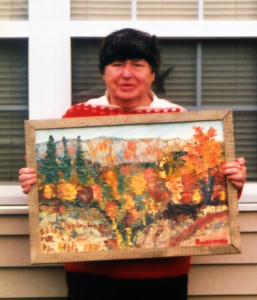 An artist and poet who has keratoconus, finds inspiration everywhere she looks and even where she doesn’t.
An artist and poet who has keratoconus, finds inspiration everywhere she looks and even where she doesn’t.
Being evacuated from her London home during World War II meant she was schooled by her mother and via correspondence courses. Balister didn’t have an eye test until she was 11, when her mother was horrified to find out her daughter could barely read the top E on the eye chart. But it hadn’t stopped her from learning. In fact, thanks to her one-on-one lessons, she could read at an early age, and she continued to excel at her studies. “It didn’t matter that I couldn’t see,” she says, “because there was no blackboard.”
In the middle of the war, while London was being bombed, a teacher asked her hunkered-down students to write a psalm of thanksgiving. Balister started writing her own poetry.
She believes her keratoconus may have caused her to withdraw a bit, increasing her ability to fantasize. In high school, she wrote a poem about a stream – something she had rarely seen. It became her first published poem, in 1945.
Balister continued to defy her disease, studying art, earning a degree in German and French from Bristol University, and teaching. She emigrated from England to Canada, where she furthered her art studies, then to West Virginia in 1967, where she raised her family. Soon after her arrival in West Virginia, an optometrist told her he had never seen corneas as large as hers. “He had hit on what was wrong,” Balister recalls, “but he didn’t know what it was.” She got special contact lenses, with dramatic results. “A whole new world opened up for me,” she says. “I realized why people thought the carpets I had cleaned were filthy.”
Her keratoconus was not officially diagnosed until 1984, when she was sent to the University of Virginia in Charlottesville. “I was examined by a corneal specialist who took one look at me and screamed, ‘Keratoconus!’ and rushed in about 20 students to look at me.”
Balister started writing poetry about her disease in the mid-1980s. “I was sick of people saying, ‘Why don’t you wear glasses and stop complaining?’ I wanted to throttle them. You can’t see with glasses,” she says. Finding a way to express her frustration was important: “You can either go around shooting everybody in sight or write a poem.”
She finally had a corneal transplant in 2001. “I have never been more frightened,” she says. “I wrote a poem called “Leavetaking”; I wrote my last will and testament. Three other people with keratoconus helped me have the courage to go through with it.” The surgery was a success. “I have pretty good vision,” she says. “On a good day, it’s 20/20.” Rosemary Balister with her painting, West Virginia Fall, which was chosen by the US ambassador to Kuala Lumpur to hang in the US embassy there. He found it through the Art in Embassies and Very Special Arts (VSA) programs.
“Leavetaking,” below, appeared in Root Me On, Poems and Thoughts About Life by writers with disabilities and their caregivers. Root Me On was published in 2003 through a poetry project in Virginia sponsored by the city of Charlottesville and Albemarle County therapeutic recreation departments, Independence Resource Center and Charlottesville/ Albermarle VSA Arts.
Leavetaking
Today I bade farewell to my old cornea.
Diseased, cone-shaped, irregular
It was yet an old friend.
In thanksgiving for the many years
Of flawed, yet faithful service
I painted what I saw through an imperfect window,
To familiarize ophthalmologists
With
The keratoconic-eye view of the world.
I may have created a masterpiece
Called “Points of Light”
Equal in beauty and impact
To “Guernica” and “Starry Night”
And turned a lemon into lemonade.
Balister’s poetry has been published in numerous books, several by Very Special Arts (VSA), a nonprofit organization founded in 1974 by Ambassador Jean Kennedy Smith. VSA aims “to create a society where all people with disabilities learn through, participate in and enjoy the arts.” Balister is involved, as both a poet and an artist, with VSA in Charlottesville, where she still resides. She says she gets a great deal of inspiration from VSA’s programs. No doubt she provides a great deal, as well.

